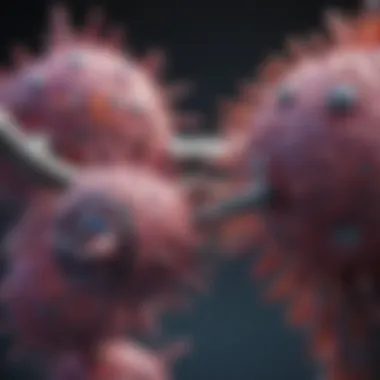Combination Therapy in Cancer Treatment: A Deep Dive


Intro
Combination therapy is gaining traction in oncology due to its potential to improve patient outcomes. This approach involves using multiple therapeutic modalities, often with distinct mechanisms of action, to combat cancer's complexity. Various therapies, including chemotherapy, radiation, targeted therapy, and immunotherapy, can be combined strategically to enhance efficacy and mitigate resistance.
Key Findings
Summary of the main results
Research indicates that combination therapy can improve overall survival rates compared to monotherapy. Clinical trials are showing that patients often respond more favorably when treated with a regimen that integrates different types of treatments. For instance, combining targeted therapy with chemotherapy can lead to a synergistic effect, where the combined impact of treatments exceeds their individual benefits.
Moreover, studies published in journals such as The New England Journal of Medicine reveal that certain combinations can reduce the occurrence of drug resistance. This adaptability is crucial as cancer cells frequently evolve, making them less responsive to single-agent treatments.
Significance of findings within the scientific community
The shift towards combination therapy signifies a broader understanding of cancer biology. The findings emphasize the importance of a tailored approach in oncology, recognizing that different tumors may respond uniquely to therapies. These insights are shaping future clinical guidelines and treatment plans, driving researchers to delve deeper into the mechanisms of combinations that may offer breakthroughs in cancer care.
Implications of the Research
Applications of findings in real-world scenarios
Implementing combination therapy in clinical settings has shown promise. For example, patients with advanced melanoma have benefited from combining pembrolizumab, an immunotherapy, with talimogene laherparepvec, an oncolytic virus therapy. This regimen has offered an enhanced response rate, thereby improving quality of life and prognosis for the affected individuals.
Potential impact on future research directions
Looking ahead, ongoing research will likely focus on identifying optimal combinations based on genetic profiles of tumors. The integration of biomarkers as predictive tools could facilitate personalized treatment strategies. This tailored approach aims to reduce side effects and improve therapeutic outcomes.
"Combination therapy represents a pivotal shift in cancer treatment paradigms, advocating for a more nuanced understanding of oncology and personalized medicine."
Research into combination strategies will continue to play a vital role in shaping the future of cancer therapy. It is critical for students, researchers, educators, and professionals to stay abreast of these developments, as the landscape of cancer treatment is continually evolving.
Prelude to Combination Therapy
Combination therapy represents a pivotal evolution in cancer treatment strategies. The importance of this approach lies in its ability to enhance the efficacy of treatments, potentially leading to better patient outcomes. The rationale for using combination therapy stems from the complex nature of cancer, which often involves multiple pathways and mechanisms of tumor growth and resistance. By integrating different therapeutic modalities, oncologists aim to tackle cancer cells from various angles, hindering their ability to adapt and survive.
One significant aspect of combination therapy is the potential for synergistic effects. This concept refers to the enhanced impact of two or more treatment modalities that, when used together, produce a greater effect than the sum of their individual effects. In the context of cancer, this means that by using two or more treatments concurrently, physicians may achieve improved tumor response rates and prolonged survival for their patients.
Moreover, combination therapy can also address the issue of therapeutic resistance. Tumor cells often develop resistance to single-agent therapies. However, employing multiple agents may help to overcome this challenge by attacking the cancer on multiple fronts, thereby reducing the likelihood of resistance development.
Considering these factors, there is an increasing emphasis on understanding the mechanisms and overall clinical applications of combination therapy, especially in light of recent advancements in personalized medicine. A nuanced understanding of each patient’s unique cancer profile can guide the selection of appropriate therapies to maximize effectiveness and minimize side effects.
As we explore the historical context and foundational aspects of this innovative approach, we will see how it has significantly shaped modern oncology.
Definition and Overview
Combination therapy, in its simplest form, is a treatment approach that involves administering two or more therapeutic modalities to combat cancer. These modalities may include a mix of chemotherapy, radiation therapy, targeted therapy, immunotherapy, and other innovative strategies. The ultimate goal is to enhance the therapeutic effect, making it more effective against a range of cancers.
The definition of combination therapy is broad and includes any grouping of treatments intended to work in concert. This can optimize tumor response while minimizing toxicity when compared to some single-agent therapies, which may only target specific aspects of tumor biology.
Historical Context
The evolution of combination therapy can be traced back to the early days of cancer treatment. Initially, cancer therapies were primarily reactive, focusing on addressing symptoms and controlling tumor growth. However, as research progressed, there emerged an understanding that cancer is not a uniform disease. This realization led to the exploration of combined modalities as a way to maximize treatment efficacy and improve patient outcomes.
In the late 20th century, the advent of chemotherapy marked a significant milestone in oncological treatment, where multiple chemotherapeutic agents began to be utilized in tandem. Since then, the landscape has broadened considerably. Studies demonstrating increased survival rates when combining chemotherapy with other therapies laid the groundwork for current practices.


Moreover, the introduction of targeted therapies and immunotherapies in the early 21st century revolutionized the treatment landscape once more, allowing for increasingly sophisticated approaches that consider the specific characteristics of each patient's cancer. This historical progression highlights the continuous adaptation and enhancement within the field, striving to meet the complex challenges presented by different cancers.
The Mechanisms of Combination Therapy
Understanding the mechanisms behind combination therapy is crucial to appreciating its role in cancer treatment. Combination therapy refers to the use of multiple therapeutic agents to enhance treatment efficacy against cancer. The primary objective is to achieve a synergistic effect, which means that the combined impact of the therapies is greater than the sum of their individual effects. Moreover, this approach addresses specific challenges posed by cancer's complexity and resistance phenomena.
Synergistic Effects
The concept of synergistic effects is a fundamental mechanism in combination therapy. Ideally, when two or more drugs are used together, they can interact in a way that amplifies their effectiveness. For instance, Cisplatin, a chemotherapy drug, can work more effectively when paired with an immunotherapy agent like Pembrolizumab. In this context, the combined action may lead to increased tumor cell death while minimizing the likelihood of overlapping toxicities. This can significantly improve patient outcomes and overall survival rates.
The rationale behind these synergistic effects is multifaceted. It often involves the targeting of different pathways within the cancer cells, ensuring that even if one pathway is blocked, others remain vulnerable. Thus, a well-executed combination can lead not only to improved cancer cell eradication but also to a potential reduction in side effects, as lower doses of each drug are often effective in combination.
Overcoming Resistance
Another essential mechanism of combination therapy is its ability to overcome drug resistance. Drug resistance can manifest in two forms: intrinsic and acquired. Intrinsic resistance occurs when cancer cells are naturally resistant to certain therapies, while acquired resistance develops when cells adapt to previously effective treatments.
The use of combination therapy can mitigate these resistance issues. By employing multiple agents that target different aspects of cancer biology, it is more challenging for cells to develop resistance. For example, combining Trastuzumab with Lapatinib in HER2-positive breast cancer creates a scenario where different pathways are simultaneously attacked. This dual assault complicates the cancer cell's adaptive response, reducing the likelihood that it can escape treatment. In recent clinical trials, the strategic pairing of therapies has led to promising outcomes, showcasing the importance of this mechanism in developing effective cancer treatment strategies.
Targeting Multiple Pathways
Cancer is a highly heterogeneous disease, with various subtypes exhibiting distinct biological behaviors. One of the notable advantages of combination therapy is its ability to target multiple pathways simultaneously. This is essential since many cancer cells possess various aberrations that drive their growth and survival.
By employing combination therapies, such as coupling Sorafenib, a targeted therapy, with traditional chemotherapy agents like Doxorubicin, researchers have observed enhanced targeting of signaling pathways. This approach not only addresses the complexity of the tumor microenvironment but also increases the chances of knocking down resistant clones of tumor cells. Key mechanisms, including apoptosis, angiogenesis, and cell cycle regulation, can be addressed through multi-pathway targeting strategies. This complexity requires a meticulous selection of agents based on the individual tumor's characteristics.
"The future of cancer treatment lies in our ability to effectively coordinate combination therapies, targeting the intricacies of the disease while minimizing adverse effects."
Types of Combination Therapy
Understanding the various types of combination therapy is critical for comprehending its multifaceted role in cancer treatment. Each approach merges different modalities to improve patient prognosis while aiming to mitigate resistance, enhance efficacy, and tackle the complexity of cancer.
Chemotherapy and Immunotherapy
Chemotherapy has been a cornerstone in cancer treatment for decades. It functions by targeting rapidly dividing cells, but its application may lead to significant side effects due to its lack of specificity. Immunotherapy, on the other hand, represents a paradigm shift. It aims to stimulate the immune system's natural defenses to recognize and kill cancer cells more effectively. When combined, these therapies can create a synergistic effect.
By enhancing the immune response while attacking cancer cells directly, this approach enhances overall effectiveness. Studies suggest that the combination of checkpoint inhibitors with standard chemotherapy may lead to better outcomes in certain cancer types, such as lung cancer.
Radiation and Chemotherapy
The integration of radiation therapy with chemotherapy, often termed chemoradiation, harnesses the strengths of both modalities. Radiation is designed to damage the DNA of cancer cells, thereby inhibiting their ability to replicate. When paired with chemotherapy, which can further sensitize cells to radiation, the results may yield improved tumor shrinkage and better local control of the disease.
This strategy has shown effectiveness in various cancers, particularly in combining radiation with cisplatin-based chemotherapy for head and neck cancers, as noted in clinical studies. The challenge remains in managing the additive toxicities resulting from this combination.
Novel Approaches in Combination Strategies
With evolving knowledge in oncology, novel approaches in combination strategies have emerged as promising options. These approaches leverage innovative therapies alongside traditional methods, aiming for a holistic treatment outcome.
Targeted Therapy
Targeted therapy is distinguished by its approach to interfere with specific molecules involved in tumor growth and progression. Its chief characteristic is the ability to selectively target cancer cells without harming normal cells, which can reduce side effects compared to traditional treatments.
For this article, targeted therapy offers significant benefits. It allows for tailored therapy based on genetic aberrations present in tumors. The unique feature of this type of therapy is its precision, focusing on mutated genes, proteins, or the tissue environment contributing to cancer growth. However, the challenges include potential resistance mechanisms and the need for biomarker testing.
Gene Therapy


Gene therapy involves modifying the genetic material within a patient’s cells. This innovative approach aims to correct defective genes responsible for disease development. The key characteristic of gene therapy lies in its potential to address the underlying genetic causes of cancer.
For this article, gene therapy represents a beneficial avenue. It holds promise in not just targeting the cancerous cells but also in potentially restoring normal cellular function. A significant feature is its capability to introduce or alter genes to fight cancer. However, this approach still faces challenges, such as delivery methods and long-term effects on patients' health.
Epigenetic Modifiers
Epigenetic modifiers work by altering the expression of genes without changing the underlying DNA sequence. They play an essential role in the regulation of gene activity, and their application in cancer treatments is becoming more recognized. The key characteristic of these modifiers is their ability to potentially reverse abnormal gene expression profiles associated with cancer.
In this article, epigenetic modifiers are advantageous as they can restore normal cellular behaviors and potentially overcome drug resistance. A unique feature of this approach is that it targets the epigenetic mechanisms behind cancer, offering another layer of treatment strategies. Nevertheless, the complexity of interactions in the epigenome poses challenges in fully realizing practicality in clinical settings.
Each combination therapy method presents unique advantages and disadvantages. As research progresses, the ongoing study of these combinations will likely yield better understanding and effectiveness in cancer treatments.
Clinical Applications
The concept of clinical applications in combination therapy is critical for understanding its practical implications in cancer treatment. A combination approach aims to enhance the efficacy of treatment regimens by utilizing multiple therapeutic modalities concurrently. This strategy addresses the multifaceted nature of cancer, which often requires more than a singular treatment to achieve remission and manage symptoms effectively. Clinical applications also provide insights into how different therapies can work synergistically to improve patient outcomes.
Case Studies and Evidence
Case studies are essential in showcasing real-world applications of combination therapy in clinical settings. Various documented cases illustrate scenarios where patients benefitted significantly from a combination of treatments. For instance, a study involving the concurrent use of pembrolizumab and chemotherapy in non-small cell lung cancer revealed improved survival rates compared to chemotherapy alone. These evidence-based approaches highlight the importance of strategically pairing therapies to amplify their effectiveness.
Additionally, other studies have analyzed patient responses to combined therapies for breast cancer, demonstrating that this strategy can not only enhance treatment outcomes but also reduce progression-free survival times. Each case strengthens the argument for implementing combination therapy as an integral part of cancer treatment protocols.
Clinical Trials and Findings
Ongoing Trials
Ongoing trials play a pivotal role in developing and validating combination therapies. These trials often explore novel pairings that have not been widely studied. Currently, many ongoing trials focus on combining targeted therapies with immunotherapies. The design of these trials is crucial as they allow researchers to assess efficacy, safety, and the potential for adverse effects systematically.
A key characteristic of ongoing trials is the adaptive trial design. This approach permits modifications based on interim results, thus enhancing the efficiency of the clinical research process. Ongoing trials are a beneficial choice because they not only offer patients access to new therapies but also contribute valuable data to the scientific community about the best treatment modalities.
A unique feature of ongoing trials is their ability to explore various patient demographics and specific cancer types, allowing for a more tailored approach to treatment. This adaptability provides an advantage in assessing how different factors can impact therapy outcomes, although challenges in patient enrollment and maintaining adequate participant retention persist.
Results and Impact
The results derived from clinical trials significantly impact the landscape of combination therapy in cancer treatment. Data from recent trials indicate that patients receiving combination therapies often experience a better overall response compared to those on single agents. This reinforces the importance of conducting robust clinical research to inform treatment protocols.
A defining characteristic of these results is the trending increase in progression-free survival rates across multiple cancer types. Such findings establish combination therapy as not only a beneficial strategy but also a popular approach among oncologists seeking to optimize treatment outcomes for their patients.
The unique aspect of these results lies in their ability to translate into practice, guiding clinicians in their therapeutic decisions. However, there could be challenges. Some trials report higher rates of adverse effects, signaling that a careful balance must be maintained between efficacy and tolerance. This dual focus is vital for refining treatment protocols.
In summary, both ongoing trials and results from clinical research profoundly shape the application of combination therapy in clinical settings. Through evidence-based findings, oncologists can make informed decisions to improve patient care, paving the way for a brighter future in cancer treatment.
Patient Considerations
Personalized Medicine and Combination Therapy
In the realm of cancer treatment, personalized medicine represents a significant shift in tailoring therapies to individual patients. This approach focuses on the unique genetic and molecular characteristics of a patient’s cancer, enabling healthcare professionals to select the most effective combination therapies. The concept of personalized medicine is particularly pertinent when discussing combination therapy. By understanding the specific tumor profile, clinicians can choose agents that target the underlying mechanisms of the cancer more precisely, rather than using a broad, conventional approach.
The use of biomarkers plays a critical role in this strategy. Biomarkers can indicate how well a patient might respond to certain therapies and can help predict potential adverse effects. When combined, therapies can act synergistically, enhancing treatment efficacy while reducing the likelihood of drug resistance. This personalized approach not only improves outcomes but also emphasizes the importance of monitoring patient response throughout the treatment process.
Moreover, the integration of patient preferences and genetic backgrounds into treatment plans plays an essential role in enhancing patient adherence to therapy. Patients who understand their treatment rationales are more likely to follow through with prescribed regimens. This highlights the need for effective communication between healthcare providers and patients to foster a supportive environment that nurtures informed decision-making.
Adverse Effects and Management


Combination therapy, while potent, can lead to a spectrum of adverse effects that clinicians must manage effectively. Understanding these potential complications is vital for optimizing patient care. The types and severity of adverse effects often depend on the specific therapies utilized, as some drugs may enhance the toxicity of others, leading to increased side effects.
Common adverse effects include nausea, fatigue, immunosuppression, and organ-specific toxicity. Detailed monitoring is essential, as timely intervention can mitigate some of these effects. Strategies for managing adverse effects include dose adjustment, supportive medications, and, in some cases, the temporary cessation of therapy. Every patient's experience is unique, and as such, management plans need to be individualized.
Additionally, educating patients about potential side effects before treatment begins can empower them to recognize and report issues early. Such awareness improves the overall treatment experience and ensures that patients feel supported throughout their journey.
"Understanding the patient's perspective and their unique situation is essential in advancing combination therapy strategies."
For further understanding of these topics, explore resources from Wikipedia, Britannica or engage with community discussions on Reddit.
Future Directions in Combination Therapy
The exploration of future directions in combination therapy is critical to advancing cancer treatment methodologies. As our understanding of cancer biology deepens, it becomes clear that the complexity of the disease necessitates multifaceted approaches. Applying combination therapy could offer substantial benefits, such as improved effectiveness in overcoming drug resistance, tailored treatment plans, and enhanced patient outcomes. This progress is not merely a theoretical exercise; it involves rigorous research and clinical trials aimed at validating new approaches.
Emerging Research Trends
Research trends are consistently evolving in the realm of combination therapy. Recent studies focus on biomarkers that predict how well a patient might respond to specific combinations of treatments. Personalized medicine is a significant component of this trend. By tailoring treatment based on individual genetic profiles, researchers aim to maximize effectiveness while minimizing adverse effects. Some promising areas of research include:
- Immunotherapy and checkpoint inhibitors: Combining traditional therapies with immunotherapies has garnered significant interest. It exploits the immune system's capability to recognize and attack cancer cells.
- Targeted therapies: New targeted agents, designed to interfere with cancer cell-specific pathways, are being tested in combination with existing treatments. This targeted approach may enhance the overall therapeutic impact.
- Concomitant therapies: The investigation into administering multiple therapeutic modalities simultaneously is gaining traction. For example, pairing chemotherapy with targeted therapies or gene editing techniques offers a new avenue for research.
Technological Innovations
Technological advancements are transforming the landscape of combination therapy. Novel platforms and methodologies enable more precise and efficient combination strategies. Key innovations include:
- Artificial Intelligence (AI): AI algorithms are meticulously analyzing large datasets to uncover patterns in cancer treatment responses. This allows clinicians to design optimal treatment combinations.
- Gene Editing: Innovations like CRISPR permit targeted modifications in the genome, potentially leading to the development of new treatment combinations that can target resistant cancer types.
- Nanotechnology: Utilizing nanoparticles for drug delivery enhances the targeting capability of therapies. This technology helps to improve the distribution of drugs within the tumor while limiting damage to healthy tissues.
Global Perspectives on Combination Therapy
The discussion of combination therapy extends beyond localized contexts. On a global scale, collaboration and knowledge sharing are vital for progress. Different regions face unique challenges, from clinical trial accessibility to varying levels of healthcare infrastructure. Noteworthy aspects include:
- International Collaboration: Sharing research outcomes across borders accelerates the adoption of successful combination therapies. Collaborative efforts can harness diverse expertise, leading to faster advancements.
- Regulatory Variations: Understanding how different countries regulate combination therapies is crucial. This insights can guide researchers and practitioners in navigating the approval processes.
- Cultural Challenges: Tailoring combination therapy approaches to fit different cultural contexts promotes wider acceptance and adherence among patients.
The future of combination therapy any depends heavily on these research trends, technological innovations, and a collective global approach. Stakeholders must remain vigilant to these areas to maximize the therapeutic potential in the fight against cancer.
Culmination
The understanding of combination therapy in cancer treatment comes from recognizing its multifaceted nature and the increasing complexity of cancer as a disease. This article encapsulates several aspects, emphasizing the importance of blending multiple treatment modalities to tackle cancer effectively. The benefits of combination therapy are noteworthy, as they can significantly enhance therapeutic outcomes compared to single-agent therapies.
Summary of Key Findings
Throughout this exploration, a few crucial findings emerge. First, combination therapy shows strong potential in enhancing the synergistic effects of treatments. By acting on various pathways simultaneously, it is possible to target cancer cells more effectively:
- Synergy improves the effectiveness of treatments.
- Administering therapies together can lead to better patient outcomes.
- Clinical trials illustrate the efficacy of using immunotherapy in conjunction with chemotherapy.
Another point of significance is the capacity of combination therapy to overcome resistance. Many cancers develop resistance to single agents. Through combination strategies, the likelihood of drugs being ineffective is reduced:
- Treatment plans should be tailored to individual patient profiles.
- Continuous research into drug resistance mechanisms is vital.
Lastly, the landscape of treatment is evolving with novel approaches. Clinical applications demonstrate diverse methods such as targeted therapies and gene therapies, indicating a shift toward more personalized cancer care.
Implications for Future Research
The inquiry into combination therapy should continue to progress as innovations emerge. Future research must focus on:
- Optimizing dosage and sequencing of therapies for maximum effect. Finding the balance between various drugs can enhance their individual and collective effectiveness.
- Understanding patient-specific factors when devising treatment plans will help tailor approaches more effectively.
- The integration of technological advancements, such as artificial intelligence in drug discovery, may further refine combination strategies, allowing for more precise targeting of cancer pathways.
Continued collaboration among researchers, clinicians, and the biotechnology industry is essential. As the evidence base expands, there is greater scope for enhancing clinical outcomes and improving survival rates.
In summary, combination therapy is a valuable approach in cancer treatment. Its importance lies not only in current successes but also in future developments that promise to refine and optimize cancer care on a global scale.







